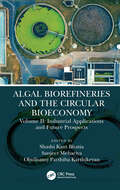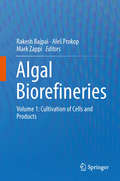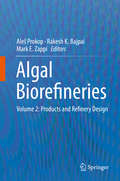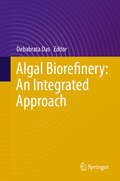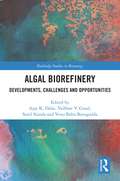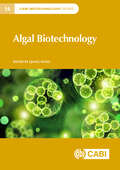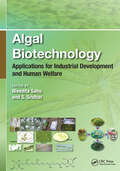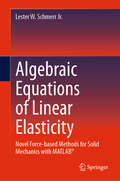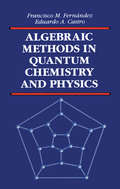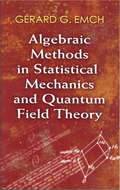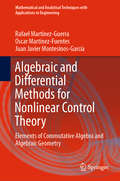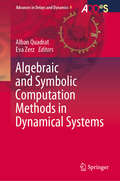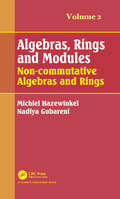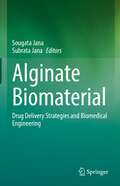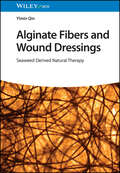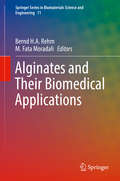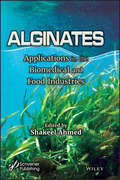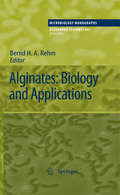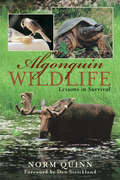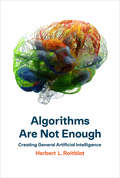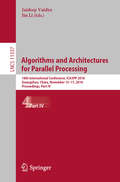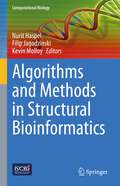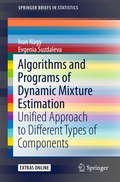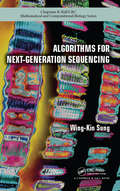- Table View
- List View
Algal Biorefineries and the Circular Bioeconomy: Industrial Applications and Future Prospects
by Shashi Kant Bhatia"Algae are mysterious and fascinating organisms that hold great potential for discovery and biotechnology." —Dr. Thierry Tonon, Department of Biology, University of York "Science is a beautiful gift to humanity; we should not distort it." —A.P.J. Abdul Kalam In this book, we emphasise the importance of algal biotechnology as a sustainable platform to replace the conventional fossil-based economy. With this focus, Volume 2 summarizes up-to-date literature knowledge and discusses the advances in algal cultivation, genetic improvement, wastewater treatment, resource recovery, commercial operation, and technoeconomic analysis of algal biotechnology. FEATURES Discusses in detail recent developments in algae cultivation and biomass harvesting Provides an overview of genetic engineering and algal-bacteria consortia to improve productivity Presents applications of algae in the area of wastewater treatment and resource recovery Provides case studies and technoeconomic analysis to understand the algal biorefinery Shashi Kant Bhatia, PhD, is an Associate Professor in the Department of Biological Engineering, Konkuk University, Seoul, South Korea. Sanjeet Mehariya, PhD, is a Postdoctoral Researcher in the Department of Chemistry, Umeå University, Umeå, Sweden. Obulisamy Parthiba Karthikeyan, PhD, is a Research Scientist and Lecturer (Adjunct) in the Department of Civil and Environmental Engineering, South Dakota School of Mines and Technology, Rapid City, South Dakota, USA.
Algal Biorefineries: Volume 1: Cultivation of Cells and Products
by Aleš Prokop Rakesh Bajpai Mark ZappiThis book reviews efforts to produce chemicals and fuels from forest and plant products, agricultural residues and more. Algae can potentially capture solar energy and atmospheric CO2; the book details needed research and legislative initiatives.
Algal Biorefineries: Volume 2: Products and Refinery Design
by Aleš Prokop Rakesh K. Bajpai Mark E. ZappiAlgae offer potential to produce renewable chemicals and fuels using solar energy and carbon dioxide from atmosphere or in flue gases while simultaneously reducing the generation of greenhouse gases. Since these can be grown on marginal lands with micronutrients and macronutrients often present in waste streams, algae-based chemicals and fuels do not compete with foods. Still large-scale production of algae-based fuels and chemicals faces considerable technological and economical challenges and it would by necessity require a biorefinery approach wherein all the possible algal components are converted into value-added compounds. The present series on algal biorefineries represents a forum for reporting the state of the art of different technologies as well as the latest advances in this field. The volume II of this series complements the volume I in terms of the current state of the art. Different chapters in this volume address diverse issues ranging from genetically modifies algae to new products to life-cycle analysis of algal products.
Algal Biorefinery: An Integrated Approach
by Debabrata DasThis book critically discusses different aspects of algal production systems and several of the drawbacks related to microalgal biomass production, namely, low biomass yield, and energy-consuming harvesting, dewatering, drying and extraction processes. These provide a background to the state-of-the-art technologies for algal cultivation, CO2 sequestration, and large-scale application of these systems. In order to tap the commercial potential of algae, a biorefinery concept has been proposed that could help to extract maximum benefits from algal biomass. This refinery concept promotes the harvesting of multiple products from the feedstock so as to make the process economically attractive. For the last few decades, algal biomass has been explored for use in various products such as fuel, agricultural crops, pigments and pharmaceuticals, as well as in bioremediation. To meet the huge demand, there has been a focus on large-scale production of algal biomass in closed or open photobioreactors. Different nutritional conditions for algal growth have been explored, such as photoautotrophic, heterotrophic, mixotrophic and oleaginous. This book is aimed at a wide audience, including undergraduates, postgraduates, academics, energy researchers, scientists in industry, energy specialists, policy makers and others who wish to understand algal biorefineries and also keep abreast of the latest developments.
Algal Biorefinery: Developments, Challenges and Opportunities (Routledge Studies in Bioenergy)
by Sonil Nanda Ajay K. Dalai Vaibhav V. Goud Venu Babu BorugaddaThis book enables readers to understand the theoretical aspects, key steps and scientific techniques with a detailed mechanism to produce biofuels from algae. Each chapter provides the latest developments and recent advancements starting from algal cultivation techniques to the production of value-added green fuels, chemicals and products with wide applications. The volume brings together a broad range of international and interdisciplinary experts, including chemical and biological engineers, biotechnologists, process engineers, environmentalists, pharmacists and nutritionists, to one platform to explore the beneficial aspects and challenges for an algal-based biorefinery. Chapters address cutting-edge issues surrounding algal cultivation, including genetic modification of algal strains, design and optimization of photobioreactors and open-pond systems, algal oil extraction techniques and algal-derived fuel products (biodiesel, bio-gasoline, jet fuels and bio-oil). Finally, the book considers the potential environmental impacts for establishing a sustainable algal biorefinery through lifecycle analysis, techno-economic assessment and supply chain management. This book will be an important resource for students, academics and professionals interested in algal cultivation, biofuels and agricultural engineering, and renewable energy and sustainable development more broadly.
Algal Biotechnology (CABI Biotechnology Series)
by Sanjay Gupta Jin Wang Vinod Kumar Xu Zhang Lei Chen Chao Li Weiwen Zhang Xinyu Song Xiaojun Yan Chengxu Zhou Roger Ruan Yahui Bo Gao Chen Zhenfan Chen Zixi Chen Pengfei Cheng Feng Ge Jiameng Guo Xiahui Hao Qingfang He Fan Hu Hanhua Hu Krishna Kumar Jaiswal Hu Jin Anping Lei Anna I. Kurbatova Yanhua Li Hanzhi Lin Lu-Ning Liu Qiong Liu Yandu Lu Anastasios Melis Yufang Pan Vishal Rajput Shengzhou Shan Kaitlin Simmons Xiaotong Song Adamu Yunusa Ugya Mikhail S. Vlaskin Chun Wang Jiangxin Wang Wenxiu Yin Xiangxiang Zhang Yu-Zhong Zhang Long-Sheng Zhao Quanyu Zhao Yali Zhu Zhu Zhen Tian Jing Cao XupengAlgae are sunlight-driven cell factories, and can efficiently absorb CO2 and convert light energy to chemical energy such as lipid, starch and other carbohydrates and release O2. Algal feedstock is a promising resource for bioproduct production, given its high photosynthetic efficiency for producing biomass compared to conventional crops. Microalgae can be used for flue-gas and wastewater bioremediation. This book highlights recent breakthroughs in the multidisciplinary areas of algal biotechnology and the chapters feature recent developments from cyanobacteria to eukaryotic algae, from theoretical biology to applied biology. It also includes the latest advancements in algal-based synthetic biology, including metabolic engineering, artificial biological system construction and green chemicals production. With contributions by leading authorities in algal biotechnology research, it is a valuable resource for graduate students and researchers in the field, and those involved in the study of photosynthesis and green-cell factories.
Algal Biotechnology: Applications for Industrial Development and Human Welfare
by S. Sridhar Nivedita SahuThis book deals with an interdisciplinary approach towards present-day practical challenges and recent developments in algal biotechnology and covers a broad spectrum of issues ranging from diverse algae and its applications in agriculture, human food, animal feed, wastewater treatment, and industry to algal metabolites. Major themes covered in this volume include algae-based processes for the treatment of industrial effluents, algal biorefinery, industrial trends, and applications of algae in food, feed, nutraceuticals, and pharmaceuticals.Features: Explores the possibility of utilization of algae in human food and pharmaceutical compounds. Presents recent state of the art of design and tools in algal biorefineries. Reviews concepts of membrane bioreactors and microbial fuel cells, including their process and performance. Algae-based technologies for safe and eco-friendly processes to promote a sustainable bio-economy. Discusses algae as a source for potential aquafeed. This book is aimed at graduate students and researchers in biotechnology, bioenergy , renewable energy, energy, fuel and petrochemicals, wastewater, novel technologies, clean technologies, bioremediation environmental biotechnology, functional foods and nutraceuticals, and marine and aquatic science.
Algebraic Equations of Linear Elasticity: Novel Force-based Methods for Solid Mechanics with MATLAB®
by Lester W. Schmerr Jr.This book describes a second-generation force-based method emerging from a general formulation where the partial differential equations of elasticity are replaced by equivalent algebraic equations. These algebraic equations of linear elasticity can be used to solve statically indeterminate problems in reduced forms that define either the new second-generation force-based approach or a new displacement-based approach. The new force-based method can serve as the basis for teaching students at many technical levels how to solve equilibrium problems directly for the forces present. In elasticity courses, the derivation and use of the algebraic equations of linear elasticity can show how the difficulties of dealing with partial differential equations may be avoided by transforming those equations into algebraic equations with work-energy concepts. In a finite element course, a force-based finite element method can be described along with the traditional displacement-based approach to demonstrate how the two methods provide alternative ways for solving complex structural problems. Serving as a resource for including second-generation force-based methods in solid mechanics courses of an engineering curriculum, and as a robust learning resource, the book is ideal for instructors and for students, practicing engineers, and researchers.
Algebraic Methods in Quantum Chemistry and Physics
by Francisco M. Fernandez E.A. CastroAlgebraic Methods in Quantum Chemistry and Physics provides straightforward presentations of selected topics in theoretical chemistry and physics, including Lie algebras and their applications, harmonic oscillators, bilinear oscillators, perturbation theory, numerical solutions of the Schrödinger equation, and parameterizations of the time-evolution operator.The mathematical tools described in this book are presented in a manner that clearly illustrates their application to problems arising in theoretical chemistry and physics. The application techniques are carefully explained with step-by-step instructions that are easy to follow, and the results are organized to facilitate both manual and numerical calculations.Algebraic Methods in Quantum Chemistry and Physics demonstrates how to obtain useful analytical results with elementary algebra and calculus and an understanding of basic quantum chemistry and physics.
Algebraic Methods in Statistical Mechanics and Quantum Field Theory
by Gérard EmchThis systematic algebraic approach concerns problems involving a large number of degrees of freedom. It extends the traditional formalism of quantum mechanics, and it eliminates conceptual and mathematical difficulties common to the development of statistical mechanics and quantum field theory. Further, the approach is linked to research in applied and pure mathematics, offering a reflection of the interplay between formulation of physical motivations and self-contained descriptions of the mathematical methods.The four-part treatment begins with a survey of algebraic approaches to certain physical problems and the requisite tools. Succeeding chapters explore applications of the algebraic methods to representations of the CCR/CAR and quasi-local theories. Each chapter features an introduction that briefly describes specific motivations, mathematical methods, and results. Explicit proofs, chosen on the basis of their didactic value and importance in applications, appear throughout the text. An excellent text for advanced undergraduates and graduate students of mathematical physics, applied mathematics, statistical mechanics, and quantum theory of fields, this volume is also a valuable resource for theoretical chemists and biologists.
Algebraic and Differential Methods for Nonlinear Control Theory: Elements of Commutative Algebra and Algebraic Geometry (Mathematical and Analytical Techniques with Applications to Engineering)
by Rafael Martínez-Guerra Oscar Martínez-Fuentes Juan Javier Montesinos-GarcíaThis book is a short primer in engineering mathematics with a view on applications in nonlinear control theory. In particular, it introduces some elementary concepts of commutative algebra and algebraic geometry which offer a set of tools quite different from the traditional approaches to the subject matter. This text begins with the study of elementary set and map theory. Chapters 2 and 3 on group theory and rings, respectively, are included because of their important relation to linear algebra, the group of invertible linear maps (or matrices) and the ring of linear maps of a vector space. Homomorphisms and Ideals are dealt with as well at this stage. Chapter 4 is devoted to the theory of matrices and systems of linear equations. Chapter 5 gives some information on permutations, determinants and the inverse of a matrix. Chapter 6 tackles vector spaces over a field, Chapter 7 treats linear maps resp. linear transformations, and in addition the application in linear control theory of some abstract theorems such as the concept of a kernel, the image and dimension of vector spaces are illustrated. Chapter 8 considers the diagonalization of a matrix and their canonical forms. Chapter 9 provides a brief introduction to elementary methods for solving differential equations and, finally, in Chapter 10, nonlinear control theory is introduced from the point of view of differential algebra.
Algebraic and Symbolic Computation Methods in Dynamical Systems (Advances in Delays and Dynamics #9)
by Alban Quadrat Eva ZerzThis book aims at reviewing recent progress in the direction of algebraic and symbolic computation methods for functional systems, e.g. ODE systems, differential time-delay equations, difference equations and integro-differential equations. In the nineties, modern algebraic theories were introduced in mathematical systems theory and in control theory. Combined with real algebraic geometry, which was previously introduced in control theory, the past years have seen a flourishing development of algebraic methods in control theory. One of the strengths of algebraic methods lies in their close connections to computations. The use of the above-mentioned algebraic theories in control theory has been an important source of motivation to develop effective versions of these theories (when possible). With the development of computer algebra and computer algebra systems, symbolic methods for control theory have been developed over the past years. The goal of this book is to propose a partial state of the art in this direction. To make recent results more easily accessible to a large audience, the chapters include materials which survey the main mathematical methods and results and which are illustrated with explicit examples.
Algebras, Rings and Modules, Volume 2: Non-commutative Algebras and Rings
by Michiel Hazewinkel Nadiya M. GubareniThe theory of algebras, rings, and modules is one of the fundamental domains of modern mathematics. General algebra, more specifically non-commutative algebra, is poised for major advances in the twenty-first century (together with and in interaction with combinatorics), just as topology, analysis, and probability experienced in the twentieth century. This is the second volume of Algebras, Rings and Modules: Non-commutative Algebras and Rings by M. Hazewinkel and N. Gubarenis, a continuation stressing the more important recent results on advanced topics of the structural theory of associative algebras, rings and modules.
Alginate Biomaterial: Drug Delivery Strategies and Biomedical Engineering
by Sougata Jana Subrata JanaThis book focuses on recent trends of research on alginate-based biomaterials in Drug Delivery strategies and biomedical engineering. It contains the widely used alginate-based biomaterials as micro to nano-controlled drug delivery (oral, ocular delivery, topical delivery, etc.) and its fabrication technology, characterization, and biomedical aspects (such as cancer therapy, tissue engineering, gene delivery, vaccine delivery, enzyme immobilization, wound healing, dental applications, etc.) in a single book. The chapters cover updated information, current research trends, informatics, and all aspects of applications. Alginate is a U.S. Food and Drug Administration (FDA)-approved natural biomaterial and has diverse biomedical applications. In recent years, researchers and scientists are working on the alginate-based drug delivery systems that have been designed and characterized as a matrix, micro to nanocarriers, fibers, composite/scaffolds, etc. Alginate has versatile properties such as biodegradable, biocompatible, nontoxic, and easily available. This book especially highlights both the drug delivery strategies and biomedical engineering aspects such as controlled drug delivery, drug targeting to the site of action, cancer therapy, gene and vaccine delivery, enzyme immobilization, tissue engineering, and regenerative medicine.
Alginate Fibers and Wound Dressings: Seaweed Derived Natural Therapy
by Yimin QinAlginate Fibers and Wound Dressings Comprehensive resource on the science and research behind alginate fibers, along with their many functional applications in different fields Alginate Fibers and Wound Dressings: Seaweed Derived Natural Therapy offers a general introduction to the sources of alginate and the production methods for alginate fibers and wound dressings, in addition to the novel properties and applications of these functional materials in wound management. Taking into consideration of the latest results of clinical researches conducted around the world, this book summarizes the unique properties of alginate wound dressings, including their ‘gel blocking’ properties and the ability to promote wound healing, facilitate haemostasis, reduce pain, suppress bacteria growth, and lower treatment cost in the treatment of a wide range of wounds, including leg ulcers, burn wounds, pressure sores, surgical wounds, and many other types of wounds with high levels of exudates. Sample topics covered in Alginate Fibers and Wound Dressings include: Why alginate fibers can be used as a carrier to deliver zinc, copper, silver, and other bioactive metal ions How alginate wound dressings can help maintain a physiologically moist microenvironment that promotes healing and the formation of granulation tissue Unique properties of alginate fibers that are highly useful for functional textile materials and medical textile products, such as gel forming properties when in contact with body fluid Other excellent performance characteristics of alginate fibers, such as haemostatic, antimicrobial, skin whitening, and many other unique bioactivities Providing comprehensive coverage of the subject, Alginate Fibers and Wound Dressings is an essential resource for students, researchers, and professionals involved in professions and programs of study that intersect with the subject.
Alginates and Their Biomedical Applications (Springer Series in Biomaterials Science and Engineering #11)
by Bernd H.A. Rehm M. Fata MoradaliThis book presents a comprehensive review of the latest advances in developing alginate-based biomaterials and derivatives as well as their biomedical and pharmaceutical applications. It covers the physiochemical properties of alginates, production and formulation methods, derivatizations and characterization methods, the fundamental work on optimizing alginate polymers for defined biomedical purposes as well as the scope and effectiveness of their applications in medicine and therapeutic approaches. The book brings together new concepts and advances in harnessing alginate-based biomaterials in combination with applied technological advances to tailor their applications to medical needs. The contributions by leading academics, clinicians and researchers not only cover the fundamentals, but also open new avenues for meeting future challenges in research and clinical applications.
Alginates: Applications in the Biomedical and Food Industries
by Shakeel AhmedAlginate is a hydrophilic, biocompatible, biodegradable, and relatively economical polymer generally found in marine brown algae. The modification in the alginate molecule after polymerization has shown strong potential in biomedical, pharmaceutical and biotechnology applications such as wound dressing, drug delivery, dental treatment, in cell culture and tissue engineering. Besides this, alginates have industrial applications too in the paper and food industries as plasticizers and additives. The few books that have been published on alginates focus more on their biology. This current book focuses on the exploration of alginates and their modification, characterization, derivatives, composites, hydrogels as well as the new and emerging applications.
Alginates: Biology And Applications (Microbiology Monographs #13)
by Bernd H. Rehm"Alginates: Biology and Applications" provides an overview of the state of art of alginate material properties, genetics and the molecular mechanisms underlying alginate biosynthesis as well as applications of tailor-made alginates in medicine, food and biotechnology. Topics treated are: material properties of alginates, alginate production: precursor biosynthesis, polymerization and secretion, bacterial system for alginate uptake and degradation, enzymatic alginate modification, alginate gene regulation, role of alginate in bacterial biofilms, microbial production of alginates: physiology and process aspects, alginate-based blends and nano/microbeads, applications of alginates in food, alginate and its comonomer mannuronic acid: medical relevance as drugs.
Algonquin Wildlife: Lessons in Survival
by Norm Quinn Cassandra Ward Dan StricklandAlgonquin Wildlife: Lessons in Survival is a celebration of the vast array of wildlife studies ongoing in Ontario’s very first provincial park. Probably more research has been done in Algonquin than in any other protected landscape in the world. Norm Quinn, long-time Park Management Biologist in Algonquin, has been fortunate to know and to work with many of those dedicated and unique wildlife researchers who roam and probe the forests and lakes in search of Nature’s secrets. His knowledge, experience and sense of humour combine to transform technical biological studies, on moose, wolves, fish and other creatures of the wild, into entertaining and inviting stories without losing the significance of the research. This is also a book about Algonquin, Ontario’s flagship Park and one of the foremost canoe-tripping wilderness sites in the world. Through Algonquin Wildlife, you are invited to explore this relatively unknown but vital part of the Park’s heritage – a must for both seasoned and budding naturalists.
Algorithms Are Not Enough: Creating General Artificial Intelligence
by Herbert L. RoitblatWhy a new approach is needed in the quest for general artificial intelligence.Since the inception of artificial intelligence, we have been warned about the imminent arrival of computational systems that can replicate human thought processes. Before we know it, computers will become so intelligent that humans will be lucky to kept as pets. And yet, although artificial intelligence has become increasingly sophisticated--with such achievements as driverless cars and humanless chess-playing--computer science has not yet created general artificial intelligence. In Algorithms Are Not Enough, Herbert Roitblat explains how artificial general intelligence may be possible and why a robopocalypse is neither imminent, nor likely.
Algorithms and Architectures for Parallel Processing: 18th International Conference, ICA3PP 2018, Guangzhou, China, November 15-17, 2018, Proceedings, Part IV (Lecture Notes in Computer Science #11337)
by Jin Li Jaideep VaidyaThe four-volume set LNCS 11334-11337 constitutes the proceedings of the 18th International Conference on Algorithms and Architectures for Parallel Processing, ICA3PP 2018, held in Guangzhou, China, in November 2018. The 141 full and 50 short papers presented were carefully reviewed and selected from numerous submissions. The papers are organized in topical sections on Distributed and Parallel Computing; High Performance Computing; Big Data and Information Processing; Internet of Things and Cloud Computing; and Security and Privacy in Computing.
Algorithms and Automation: Governance over Rituals, Machines, and Prototypes, from Sundial to Blockchain
by Denisa Reshef KeraTo enact the book’s central theme of automation and human agency, the author designed a Bot trained on her book to support dialogue with the content and facilitate discussions. If you like to compare what the author says and Bot ‘interprets’ or generates, go here https://www.anonette.net/denisaBot/ Algorithms and Automation: Governance over Rituals, Machines, and Prototypes, from Sundial to Blockchain is a critical examination of the history and impact of automation on society. It provides thought-provoking perspectives on the history of automation and its relationship with power, emphasizing the importance of considering the social context in which automation is developed and used. The book argues that automation has always been a political and social force that shapes our lives and futures, rather than a neutral tool. The author provides a genealogy of automation, tracing its development from ancient rituals to modern-day prototypes, and highlights the challenges posed by new technologies such as blockchain and artificial intelligence. The volume argues that we need more democratic and accountable governance over technological innovation to ensure that it respects human rights, political pluralism, legitimacy, and other values we hold dear in our institutions and political processes. An engaging read on a fascinating topic, this book will be indispensable for scholars, students, and researchers of science and technology studies, digital humanities, politics and governance, public policy, social policy, system design and automation, and history and philosophy of science and technology. It will also be of interest to readers interested in the interactions of the sciences and the social sciences and humanities.
Algorithms and Methods in Structural Bioinformatics (Computational Biology)
by Nurit Haspel Filip Jagodzinski Kevin MolloyThe three-dimensional structure and function of molecules present many challenges and opportunities for developing an understanding of biological systems. With the increasing availability of molecular structures and the advancing accuracy of structure predictions and molecular simulations, the space for algorithmic advancement on many analytical and predictive problems is both broad and deep. To support this field, a rich set of methods and algorithms are available, addressing a variety of important problems such as protein-protein interactions, the effect of mutations on protein structure and function, and protein structure determination. Despite recent advancements in the field, in particular in protein folding with the development of AlphaFold, many problems still remain unsolved.In this book we focus on a number of topics in Structural Bioinformatics: Cryo-EM structural detection, protein conformational exploration, elucidation of molecular binding surface using geometry, the effect of mutations, insertions and deletions on protein structural stability, and protein-ligand binding.
Algorithms and Programs of Dynamic Mixture Estimation: Unified Approach to Different Types of Components (SpringerBriefs in Statistics)
by Ivan Nagy Evgenia SuzdalevaThis book provides a general theoretical background for constructing the recursive Bayesian estimation algorithms for mixture models. It collects the recursive algorithms for estimating dynamic mixtures of various distributions and brings them in the unified form, providing a scheme for constructing the estimation algorithm for a mixture of components modeled by distributions with reproducible statistics. It offers the recursive estimation of dynamic mixtures, which are free of iterative processes and close to analytical solutions as much as possible. In addition, these methods can be used online and simultaneously perform learning, which improves their efficiency during estimation. The book includes detailed program codes for solving the presented theoretical tasks. Codes are implemented in the open source platform for engineering computations. The program codes given serve to illustrate the theory and demonstrate the work of the included algorithms.
Algorithms for Next-Generation Sequencing (Chapman & Hall/CRC Computational Biology Series)
by Wing-Kin SungAdvances in sequencing technology have allowed scientists to study the human genome in greater depth and on a larger scale than ever before – as many as hundreds of millions of short reads in the course of a few days. But what are the best ways to deal with this flood of data? Algorithms for Next-Generation Sequencing is an invaluable tool for students and researchers in bioinformatics and computational biology, biologists seeking to process and manage the data generated by next-generation sequencing, and as a textbook or a self-study resource. In addition to offering an in-depth description of the algorithms for processing sequencing data, it also presents useful case studies describing the applications of this technology.
